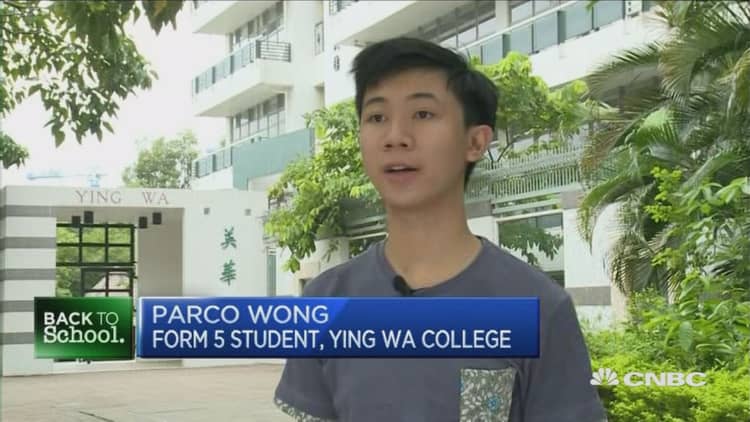
When it comes to mapping out her future, 18-year-old Koyena Pal is more clear-eyed than most students her age.
A senior at Singapore's Global Indian International School, Pal is committed to studying computer science for a career in artificial intelligence. She's already written a research paper on cyber security and now has her sites set on premier tech school MIT.
"My school grades are fine and everything. But in these kinds of universities, everybody's grades are good," Pal says. "So how do they really give you the points and everything?"
To boost her chances of acceptance, Pal has turned to Cialfo, a Singapore-based college prep course that combines traditional offline tutoring with data analytics, to crack the admissions code.
Founders Rohan Pasari and Stanley Chia incorporate school grades, test scores, extracurricular activities and even internships into a complex algorithm. Pasari calls it an academic "black box" that can determine a student's chances of acceptance.
"This is based on thousands of data points that we've collected. A lot of the data comes from our own students who we've helped in Singapore to get into top colleges in the U.S. and U.K.," Pasari says. "Plus, we're working with former admissions officers in some of these colleges, who are helping us in a qualitative way."
Cialfo's algorithm comes up with a shortlist of colleges that best fit an individual student's profile. Cialfo's tutors then use that to develop a comprehensive online checklist aimed at helping their client get into their dream school. The platform connects school counselors and parents to the student's checklist, so everybody involved in the education process is on the same page.
"Our experience shows that as much as you have to educate the student, you have to educate and mentor the parents as well," Pasari notes. "They are as invested in the process as the students are."
Sports teams have long used predictive analytics to identify the potential of athletes, but tutoring services are increasingly utilizing big data, to give students a leg-up in a hyper-competitive admissions environment. Earlier this year, Hobsons, a leading provider of college readiness courses in the U.S., acquired the Predictive Analystics Reporting Framework, a national, multi-school data-mining project, allowing the company to significantly expand the pool of data it draws from.
"It's a whole new way of learning that can come into the picture, where individuals can understand who they are, as opposed to being told by the teacher who they are," Sandeep Aneja, a Managing Partner with Kaizen Private Equity, says.
Aneja invests exclusively in education technology start-ups in emerging markets; he says data analytics is just one example of how technology is leveling the global playing field in education.
In Asia, the education tech market is already valued at $4 billion, driven by the fierce competition to get into the top universities. On average, Asian families spend 10 percent to 20 percent of their disposable income on a child's education, according to Aneja.
Start-ups haven't been limited to online-offline companies like Cialfo; tutor matching services, language apps that use chatbots, and online education sites like Coursera, which offer free classes from the world's top universities, are all the space.
"For the first time, you don't need to have full classrooms built up, you do not need to have everybody sitting in the top tier colleges," Aneja says. "That remaining 95% percent of college students can also learn from the content of 5 percent colleges through simple stuff such as caption data lectures in classrooms, putting them on the web, and transmitting them to other college classrooms."
The increasing reliance on technology has raised questions about individuality, and the risk of students overlooking their unique personal strengths, with so much focus on big data. Pasari says that's one reason why Cialfo combines traditional tutoring with its tech elements, a formula that has placed all 600 of their clients in U.S. and U.K. universities so far, according to the company.



"At the end of the day, it's the human beings who are looking at the essay, looking at the extracurricular activities and pitching to their board of admissions officers," Pasari says. "We don't want to claim that the shortlist we recommend is the end-all. This just helps you objectively look at where you stand."
Pal's short list included MIT, Carnegie Mellon University and Columbia University - all schools that her mother Moutushi Pal considers "a parent's dream."
"We are expecting a big change in her career, all-around development, the way of talking, the way of marketing, and getting into a good career," Moutushi says.
With just two months to before the application deadline, Pal is now focused on writing her personal essay in the hope it sets her apart from the pack.
"It's just like a dream right now, so I'm like 'calm down, Koyena, calm down.' Just get through this first," she says.


